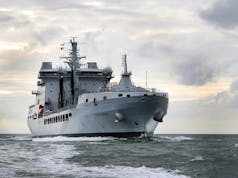BAE Systems has signed a contract with the Australian Government to further refine its design of the Type 26 Frigate for the Royal Australian Navy.
BAE Systems Australia Chief Executive, Glynn Phillips, said:
“We look forward to demonstrating the adaptability and maturity of the Global Combat Ship design to meet Australia’s requirements for an Anti-Submarine Warship frigate.
The Global Combat Ship design is the most modern, adaptable and flexible of all possible options available today, and I am confident that we will be able to demonstrate that it is the best able to meet the requirements of the Royal Australian Navy.”
In coming months, a team of BAE Systems’ Australian engineers will be deployed to the UK to join the Company’s established design team.
Being embedded into the one of the most advanced warship building teams in the world will allow these engineers to acquire the skills and knowledge required to effectively transfer the technology to Australia.
BAE Systems is using the latest in modern digital planning capability to refine and tailor its designs to the Commonwealth of Australia’s requirements.
To assist this process, the Company has revealed that, a 3-dimensional visualisation suite will be delivered to Australia to help improve understanding of the unique features of the ship design. This will enable conversations about design modifications the Royal Australian Navy requires and will help demonstrate how the Global Combat Ship could accommodate the required CEA Technologies’ phased-array radar system.
This is part of the Australian Department of Defence’s Competitive Evaluation Process for the programme. Australia has also entered into similar agreements with Fincantieri and Navantia.
Last year, a report by think-tank RAND advised that using an existing design, most likely Britain’s Type 26 Frigate, for the warships would be the least risky option for Australia. RAND looked at three design and build options; an off-the-shelf design, a modified off-the-shelf design and an entirely new design.
“Each option would entail different risks and implications for the acquisition process and strategy. The pure military off-the-shelf solution (which most likely would be built outside Australia) probably would entail the least design and cost risk, given that there would be an experienced builder and active supplier base.”
The Australian Defence Department confirmed no commitment would be made before the White Paper was released.
The Type 26 represents the future backbone of the Royal Navy and a massive leap forward in terms of flexibility of surface vessels enjoyed by the service. It will replace 8 of 13 Type 23 Frigates and export orders are being sought after by BAE. The programme has been underway since 1998, initially under the name “Future Surface Combatant”.
International competition to build the Australian frigate fleet started after Australia changed plans for their new frigate ahead of the release of their defence white paper.
The original plan detailed by former Defence Minister David Johnston, would have utilised the hull of the air warfare destroyer programme as the basis for the new class of frigate.
Australian Strategic Policy analyst Dr Andrew Davies said:
“It was a sensible decision given the destroyer hull was not really suited to the submarine hunting role of a purpose-built frigate, it was supposed to be a low-risk option but it was also more about preserving jobs than the Navy getting the warship it needs.”













So, a design contract.
ho hum….
This thing will still be vapourware for years to come.
Just what the project needs, more design consultants. Unless they can chivvy it along a bit
The Australians have also signed similar contracts with Fincantieri and Navantia which covers all three of the bidders that have been down-selected for the final choice. I suspect a big part of these contracts relate to confidentiality and intellectual property protection to enable Australian evaluators to look in detail at the competing designs.
It’s certainly a step in the right direction. If we can get a final agreement from them and reduce build cost over several buyers it could enable a price drop in the UK fleet.
With another country ordering it could also speed up production.
Takes far too long to design these ships .
BAe are taking the UK and Australian tax payer for a long ,long, ride
what’s needed is hulls in the water – whatever the design!